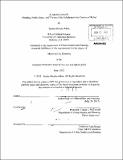| dc.contributor.advisor | Ceasar L. McDowell. | en_US |
| dc.contributor.author | Adina, Seema Ghizala | en_US |
| dc.contributor.other | Massachusetts Institute of Technology. Dept. of Urban Studies and Planning. | en_US |
| dc.coverage.spatial | a-af--- | en_US |
| dc.date.accessioned | 2012-09-27T18:11:50Z | |
| dc.date.available | 2012-09-27T18:11:50Z | |
| dc.date.copyright | 2012 | en_US |
| dc.date.issued | 2012 | en_US |
| dc.identifier.uri | http://hdl.handle.net/1721.1/73435 | |
| dc.description | Thesis (M.C.P.)--Massachusetts Institute of Technology, Dept. of Urban Studies and Planning, 2012. | en_US |
| dc.description | Cataloged from PDF version of thesis. | en_US |
| dc.description | Includes bibliographical references (p. 102-104). | en_US |
| dc.description.abstract | This thesis will review how public spaces in Kabul, Afghanistan will be affected by plans for development and formalization under proposed city plans. The core argument is that these processes of development under guises of modernity, combined with the inconsistencies of land rights and a vast informal population within the city of Kabul are challenging the existence of these valuable public spaces. The existence of these spaces are of significant importance as they are places in which residents of Kabul from a myriad of ethnic backgrounds and income levels interact, indicating that they have broader social implications than just physical space. The vision of Kabul as a failed city is one that perpetuates its marginalization and the exploitation of the majority of its informal population. In turn, the lack of publicly available salient data contributes to the misconceptions of the city. The West propagates these struggles as it allows itself to define its own superiority in the subaltern nature of the Other. Kabul Jadid, the plan for urban development in Kabul commissioned by King Amanullah Khan in 1923, followed by the Three Master Plans for Kabul made in the 1960s-1970s are examined in relation to its trajectory for how modernity was imagined for Kabul. While this developed the lens under which this paper was written, several interviews were conducted with a number of demographically varied Afghans from both in and out of Afghanistan. From these interviews, the three most frequented spaces in the city of Kabul emerged: Shahri Now, Mandawi, and Mikrorayon 3. Current and potentially future urban development in Kabul threatens these three spaces. The potential eradication or exclusive nature of these spaces also pose a number of planning challenges concerning informality and land rights, the concept of unmapping people, and the involvement of the community in the process of planning the city. However, there are a number of physical interventions that can be strategized in order to protect these spaces. The questions this thesis will seek to answer are: How are plans for development and formalization under guises of modernity in the Third Master Plan challenging the existence of valuable public spaces in Kabul, Afghanistan? How can what Kabulis identify as valuable public spaces for gathering be used to strategize preservation of these space under the Third Master Plan and future plans? | en_US |
| dc.description.statementofresponsibility | by Seema Ghizala Adina. | en_US |
| dc.format.extent | 107 p. | en_US |
| dc.language.iso | eng | en_US |
| dc.publisher | Massachusetts Institute of Technology | en_US |
| dc.rights | M.I.T. theses are protected by
copyright. They may be viewed from this source for any purpose, but
reproduction or distribution in any format is prohibited without written
permission. See provided URL for inquiries about permission. | en_US |
| dc.rights.uri | http://dspace.mit.edu/handle/1721.1/7582 | en_US |
| dc.subject | Urban Studies and Planning. | en_US |
| dc.title | STAKING SPACE : planning, public space, and visions of the subaltern in the context of Kabul | en_US |
| dc.title.alternative | Planning, public space, and visions of the subaltern in the context of Kabul | en_US |
| dc.type | Thesis | en_US |
| dc.description.degree | M.C.P. | en_US |
| dc.contributor.department | Massachusetts Institute of Technology. Department of Urban Studies and Planning | |
| dc.identifier.oclc | 809694082 | en_US |
